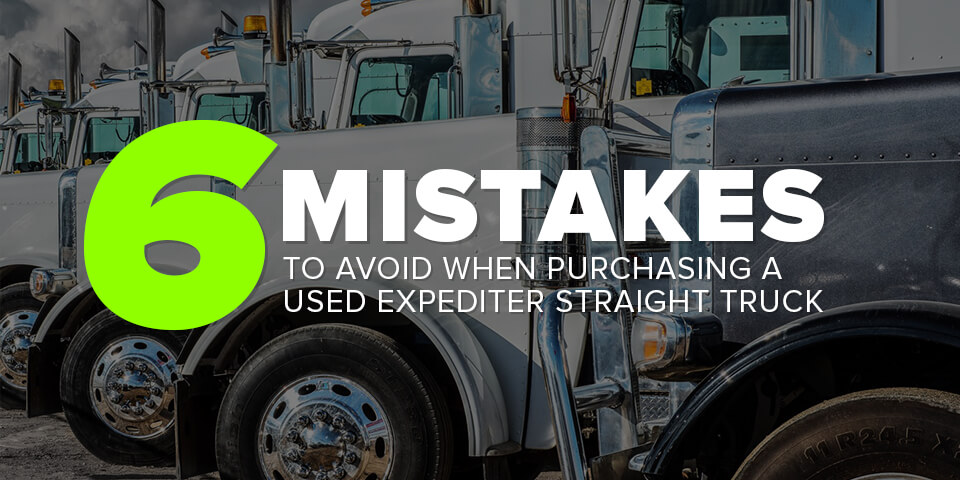In The News

6 Mistakes to Avoid When Purchasing a Used Expediter Straight Truck
If you’re new to expedited trucking or a fleet owner looking to expand, a used expediter straight truck can save you money upfront. But it also brings big risks that could sink your business if you’re not careful.
So, how can you improve your odds of making a smart purchase decision—and protect your financial future? Avoid these six mistakes when shopping for a used truck.
Mistake #1. Choosing an undersized engine.
The engine size is crucial to determining whether the truck will last long enough to be suitable for your needs. That’s because a Class-7 medium-duty engine is rated for about 300,000 miles, while the bigger Class-8 heavy-duty engine (like the Detroit DD13) is built to last a million or more miles.
The temptation is to choose a truck with the smaller engine because you can get it for a significantly lower price. But if you’re evaluating two straight trucks—one with the Class-7 and the other with the larger motor—and they both have 250,000 miles on them, you’re looking at a wide gap between those trucks in terms of the usable life remaining.
That’s because the medium-duty engine with 250,000 miles has only one or two years at most left on it, while the Class-8 engine with the same mileage could last another five to six years in most expedited trucking applications.
That difference in engine size—and longevity—could make or break your business.
Mistake #2. Overlooking engine hours.
It’s one thing to look at the miles, but the engine hours could also make a big impact on how much life you can expect out of the truck you’re about to purchase.
Engine hours refer to the amount of time the engine runs, including when the truck is idle. And although the engine isn’t under a heavy load to propel the truck when idling, it’s still encountering wear and tear that’s not reflected in the engine miles.
“One thing I do [when we take a truck in on trade] is look up the engine hours and calculate the percentage of how much those hours are idle time,” says Nathan Meyer, expediter sales at Stoops Freightliner-Quality Trailer (http://truckcountry.com/).
What percentage would be a good rule of thumb to look for?
“You want to see that number as low as possible, somewhere in the 10 to 15-percent range would be really good.”
Mistake #3. Not considering Diesel Particulate Filter (DPF) maintenance.
When was the DPF last serviced?
This is important to know because if it has been a while since the DFP was cleaned, you’ll need to factor that maintenance cost into your decision.
“I would recommend when you’re buying a used truck to get proof that the filter has been cleaned. And if it has not, go ahead and clean it,” advises Bobby Snyder, sales representative, Fyda Freightliner Columbus.
What does that typically cost?
Snyder says that DPF maintenance ranges anywhere from $800 to $1,800.
“When we take a truck in on trade, we ask for proof that the DPF has been cleaned. If that has been done in the last 100,000 to 150,000 miles, we tell the purchaser and provide them that paperwork,” says Snyder.
Says Meyer, “If the owner doesn’t have any records of the DPF being replaced or cleaned, you can take it into a shop like ours at the dealership, and we can hook up to the computer and tell how much life is left in the filter. [The report] will give you a percentage based on how full the filters are. It doesn’t necessarily translate into how long you’ll be able to run the truck but at least you know about where the truck falls in the lifecycle of the filter.”
Mistake #4. Neglecting downside planning.
When you’re purchasing a used truck, you’re taking a risk. And you won’t have much, if any, factory warranty left to cover catastrophic component failures. So, if the truck breaks down six months to a year from now, do you have enough cash to pay for the repairs—and keep your business afloat during that downtime?
“If the previous owner didn’t maintain the truck and it needs a few items fixed, you can rack up pretty healthy bills at any service department,” says Snyder.
Meyer agrees, “One big repair and that could wipe you out before you even get started in the business.”
How much cash should you put away?
“Build up a maintenance fund of about 10-cents per mile, and as the truck gets older I’d increase that amount,” Snyder advises. “Having enough cash on hand to operate your business and not just acquire your equipment is something that you really need to consider before buying the truck.”
Mistake #5. Trying to reinvent the wheel.
Snyder says that he has seen some inexperienced expediters try to “reinvent the wheel” by modifying a truck instead of purchasing one that was built originally for the expedited trucking industry.
”They’ll say, ‘I think I’m going to buy a tractor and stretch it and put my own box on it.’ But then you’ve got to pay somebody cash to stretch the chassis and buy a box for it,” says Snyder. “I’ve seen some pretty shoddy equipment out there on the roads, especially if they try and save a couple dollars along the way instead of doing it once and doing it right. There’s enough used equipment out there right now that was designed specifically for the expediting industry. So I think that’s where you should focus your attention.”
Mistake #6. Not considering carrier requirements.
You purchased a truck only to discover that you’ll need to invest more money into it to meet your carrier’s specifications. And those modifications can get expensive.
“Make sure that you clearly understand what your carrier wants and then verify that the trucks fit those parameters or qualifications before you make the purchase,” says Meyer.
The Bottom Line
While a used truck can help you save money upfront, it also increases your risk of unexpected surprises that could cost you more than you expect down the road. So avoid these six mistakes to increase your likelihood of purchasing a good reliable used truck that will help you operate cost-effectively and grow your business for years to come.





